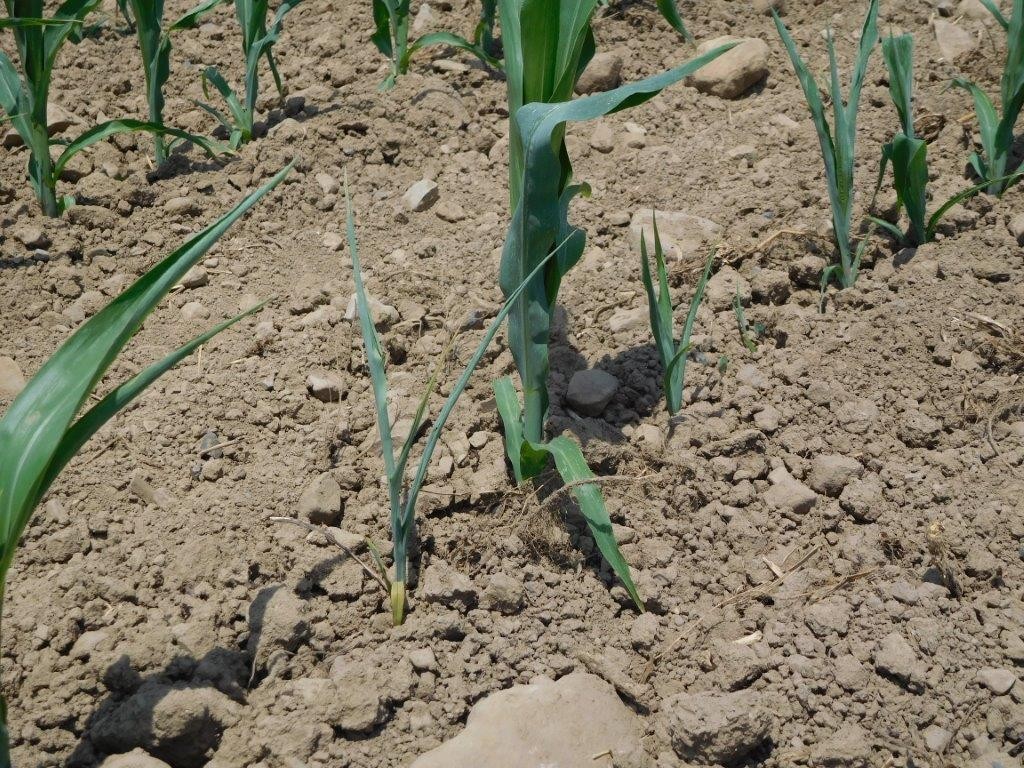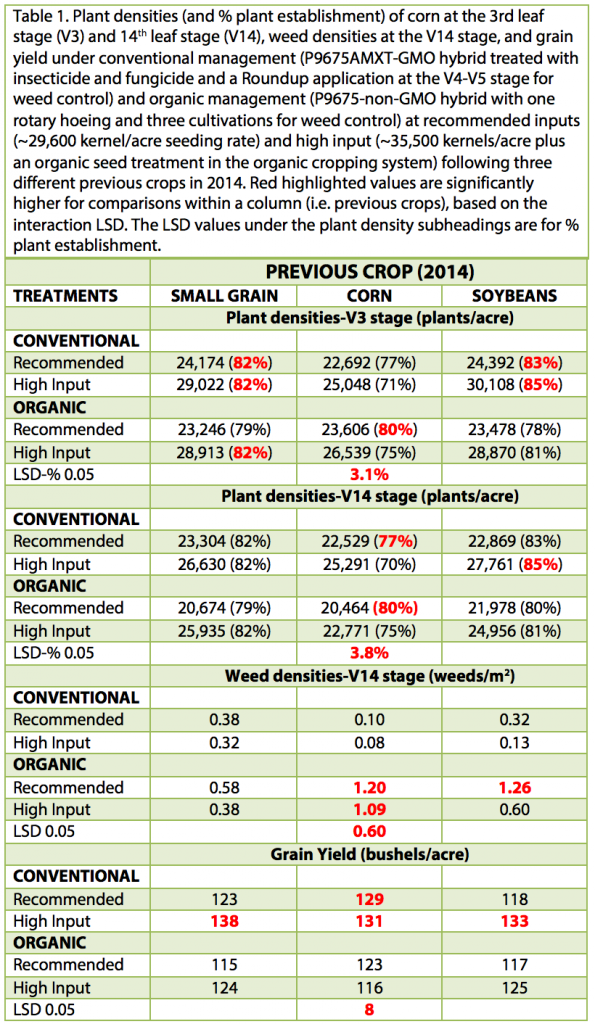By Bill Cox1, Eric Sandsted1, Phil Atkins2, and Brian Caldwell1
1Soil and Crop Sciences Section – School of Integrated Plant Science, Cornell University; 2New York State Seed Improvement Program

We initiated a 3-year study at the Aurora Research Farm in 2015 to compare different sequences of a corn, soybean, and wheat/red clover rotation in conventional and organic cropping systems with recommended and high input management during the 3-year transition period (2015-2017) from conventional to an organic cropping system. We provided detailed discussions of the experiment (https://blogs.cornell.edu/whatscroppingup/2015/11/09/corn-yield-under-conventional-and-organic-cropping-systems-with-recommended-and-high-inputs-during-the-transition-year-to-organic/) and the timing of management practices in 2016 and weather conditions through July of 2016 in previous soybean articles (https://blogs.cornell.edu/whatscroppingup/2016/07/27/emergence-plant-densities-v3-stage-and-weed-densities-v14-stage-of-corn-in-conventional-and-organic-cropping-systems-in-2016/).
Briefly, a preceding red clover green manure crop (~3.75 dry matter tons/acre) was mowed down on May 18. Dry weather conditions (1.9 inches in March, 1.87 in April, and 1.35 inches from May 1-19), exacerbated by the robust red clover crop, made soil conditions exceedingly dry so plow penetration was difficult in some regions of the fields on May 19. We planted a treated (insecticide/fungicide seed treatment) GMO corn hybrid, P96AMXT, in the conventional system; and its isoline, the untreated non-GMO, P9675, in the organic cropping system at two seeding rates, ~29,600 kernels/acre (recommended input treatment) and 35,500 kernels/acre (high input) on May 20. The high input organic treatment also received the organic seed treatment (in-hopper), Sabrex. We applied Roundup at 32 oz. /acre for weed control in conventional corn at the 4th-5th leaf stage (V4-V5 stage) on June 22 under both recommended and high input management. We also side-dressed the high input treatment with 60 lbs. N/acre. We used the rotary hoe to control weeds in the row in recommended and high input organic corn at the V1-2 stage (June 9). We then cultivated close to the corn row in both recommended and high input organic treatments at the V3 stage (June 15) with repeated cultivations between the rows at the V4-V5 stage (June 22) and again at the V7-V8 stage (July 1). We harvested the crop on November 3 when conventional corn averaged 20.3% and organic corn averaged significantly lower at 19.6% moisture.
Corn plant densities at the V3 stage (June 14), just prior to the close cultivation to the corn row on June 15 but after the rotary hoeing, were relatively low in 2016 (Table 1), undoubtedly because limited rainfall coupled with the robust green manure crop resulted in dry planting conditions. Conventional (70 to 85% plant establishment) and organic corn (75 to 82% plant establishment) had similar plant densities at the V3 stage, unlike 2015 when conventional corn had greater plant establishment. Conventional and organic corn in the high input treatment averaged ~28,000 plants/acre (Table 1), which usually results in close to optimum yield (http://scs.cals.cornell.edu/sites/scs.cals.cornell.edu/files/shared/documents/wcu/WCUvol23no1.pdf). Conventional and organic corn in the recommended input treatment averaged only ~23,500 plants/acre (Table 1), which typically results in yield reductions in most growing seasons. Unfortunately, dry conditions persisted (0.74 inches in June and 1.89 inches in July) so plant densities decreased further by the V14 stage probably because of crop mortality in conventional and a combination of crop mortality and crop damage by cultivation in organic corn. Consequently, conventional corn at the V14 stage (1300 fewer plants/acre or a ~5% decrease from V3 to V14) compared with organic corn (3150 fewer plants/acre or a ~12% decrease) now had greater plant densities (Table 1). Such low plant densities in the recommended input treatment in conventional (~23,000 plants/acre) and organic corn (~21,000 plants/acre) should reduce yields, even in a dry growing season, because of the limited capacity of corn to compensate at low plant densities.
Weed densities at the V14 stage were also quite low in 2016 (Table 1) because of the lack of significant rainfall events required to initiate weed emergence after cultivations in organic corn or herbicide application in conventional corn. Although weed densities were mostly higher in the organic cropping system, weed densities ranged from only 0.38 to 1.26 weeds/m2 (compared with 1.61 to 3.10 weeds/m2 in 2015), which probably had limited impact on yield. Weed densities in the conventional cropping system ranged from 0.08 to 0.38 weeds/m2, which indicates excellent efficacy of a Roundup application on drought-stressed weeds that emerged after the May 20 planting date and before the June 22 Roundup application.
Conventional compared with organic corn yielded ~7% higher in 2016 (Table 1). Yields, however, were low because of exceedingly dry conditions, including during the critical 2 week period before and after silking (~July 25). Grain yield did not correlate with plant densities at the V3 stage, but had a highly significant correlation with plant densities at the V14 stage (r=0.46, Table 2). Grain yield, however, had virtually no relationship with weed densities in 2016 (Table 2). In 2015, the 20 to 40% lower yield in organic compared with conventional corn in the first transition year (no red clover green manure crop was in place) was associated with lack of soil N availability in organic corn (https://blogs.cornell.edu/whatscroppingup/2015/11/09/corn-yield-under-conventional-and-organic-cropping-systems-with-recommended-and-high-inputs-during-the-transition-year-to-organic/).The 3.5 ton/acre red clover green manure crop probably provided adequate soil N to both organic and conventional corn in 2016 (although the release of N was slow because of the dry conditions). On the other hand, the robust red clover crop probably also contributed in part to the low establishment rates and subsequent low corn yields.
Likewise, high compared with the recommended input treatment in corn yielded significantly higher (Table 1). Although not a significant 2-way interaction (p=0.08), high compared with recommended input had a 9.2% yield advantage in conventional corn compared with a 3.2% yield advantage in organic corn. Again, the higher yield in high compared with recommended input, especially in conventional corn, was associated with the higher plant densities at the V14 stage. Despite yielding ~11 bushels/acre higher, the high input compared with the recommended input treatment in conventional corn would not provide greater partial returns at a ~ $4.00/bushel corn selling price because greater seed (6000 more seeds/acre) and N costs (60 lbs./acre of side-dressed N in the high input) offset the greater partial returns.
In conclusion, organic compared with conventional corn yielded ~7% lower in 2016, the second year of the transition from conventional to an organic cropping system. In contrast, organic compared with conventional corn yielded 20-40% lower during the first transition year in 2015 when a green manure crop was not in place. Based on the results of this study, planting a green manure crop to build-up the soil N supply during the first transition year, followed by corn in the second year, is probably a viable strategy instead of planting corn in the first year of the transition period. Corn will follow a wheat/red clover crop as well as soybean (unable to plant wheat after soybean harvest this year because of green stem in soybean and a record wet October) in 2017 so we will be comparing corn in a corn-soybean-corn rotation and in a soybean-wheat/red clover-corn rotation next year. Corn will be eligible for the organic premium in 2017 because 36 months would have elapsed from harvesting conventional spring barley (August), soybean (October) and corn (early November) in 2014, provided we delay corn harvest until the second week of November. Consequently, the inability to plant wheat after soybean harvest this year may be a blessing in disguise because of low current wheat prices and the eligibility of corn for the organic price premium in 2017.



